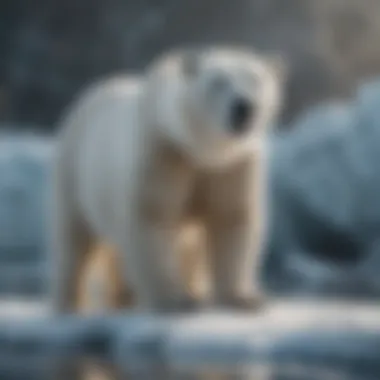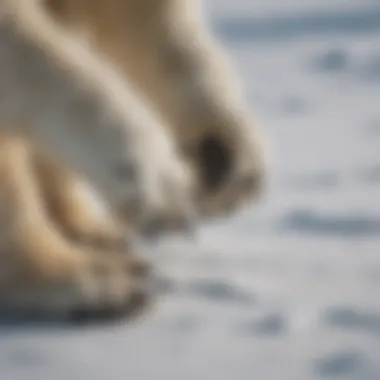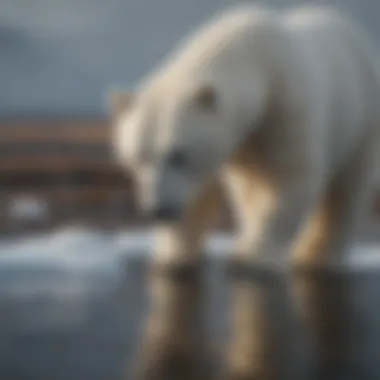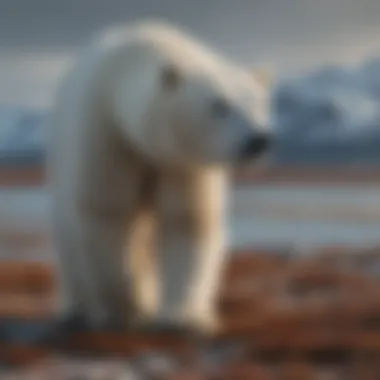Three Fascinating Facts About Polar Bears Revealed


Intro
Polar bears are among the most fascinating animals found in the Arctic regions. Their unique adaptations allow them to survive in some of the harshest environments on Earth. This article explores three interesting facts that reveal their intriguing biology and ecology. By understanding these aspects, we can see how climate change is threatening their habitat and survival.
Nature Topic Overview
The polar bear, or Ursus maritimus, is specially built to live and thrive mainly on ice. They have a thick layer of fat and dense fur which helps insulte them from the chilling temperatures. These adaptations not only keep them warm but also seem to play key roles during hunting.
Many children might think polar bears are just big fluffy teddy bears. But it is vital to understand their role in the Arctic ecosystem and how they interact with the ice and other wildlife. We will see why learning about them is so important.
Fun Facts and Trivia
- Polar bears can swim over 60 miles at one time! Their powerful front limbs help them paddle through icy waters.
- They have a special layer in their skin that helps break up the sun's rays, acting like high-tech solar panels.
- Polar bear fur is actually clear. Although it looks white, it is not. This color helps them blend into their snowy habitat quite well.
These facts stir curiosity and show just how remarkable these creatures are. With quiz or puzzles, children can test their knowledge about these amazing facts to learn even more.
Environmental Awareness
Conservation is essential when it comes to polar bears. Climate change is melting their ice habitat. This loss of ice affects their ability to hunt and find food. A fewer number of seals can mean hardship for the bears.
Here are few actions children can take to help protect these magnificent animals:
- Reduce Energy Use: Turn off lights when not needed.
- Use Less Plastic: This keeps oceans cleaner and safer for marine animals.
- Spread Awareness: Talk to friends and family about the importance of polar bear conservation.
“Helping protect polar bears is about saving a piece of our planet’s beauty for generations to come.”
DIY Nature Activities
Getting involved with nature can be fun and educational. Here are steps for hands-on activities:
- Build a Polar Bear Habitat: Use cardboard, glue, and cotton balls to create a visual aid.
- Make a Wildlife Journal: Observe nature in your local area, writing down your own facts about what you see and learn.
- Outdoor Exploration: Visit local parks or nature centers. Look for any signs of polar climate trends, like setting up outdoor walks or even searching for online animal safaris!
By engaging in these activities, children do not just learn about polar bears but also become more connected to their role in protecting the environment.
Encouraging curiosity and creativity enhances our appreciation for wildlife, especially for such significant creatures like polar bears.
Prelude to Polar Bears
Polar bears, known as Ursus maritimus, are awe-inspiring creatures of the Arctic. They hold a critical position in their ecosystem and are remarkable for their adaptations to extreme cold. Understanding polar bears is vital, as their existence reflects the looming challenges faced by the environment. This section introduces the significance of these majestic animals and sets the stage for more in-depth exploration of their unique characteristics.


Defining Polar Bears
Polar bears are the largest land carnivores in the world. They typically weigh between 330 to 1,500 pounds, depending on their gender and health. Adult males are generally larger than females. Their body length can range from 7 to 10 feet. Polar bears have a thick layer of fat and a dense coat of fur covering their bodies. This insulation helps them endure frigid temperatures, often reaching -50°F. Their skin beneath the fur is black, absorbing heat from the sun. Their coloring gives them an edge, as it provides camouflage in their icy habitats. They are found primarily in the Arctic regions, like Alaska, Canada, and parts of Russia and Greenland.
Importance in Arctic Ecosystem
The role of polar bears in the Arctic ecosystem is multifaceted and essential. As apex predators, they help control the populations of seals, which are their primary prey. This predatory behavior maintains a balance within the marine ecosystem. Without polar bears, the impacts could ripple through the food web, potentially leading to overpopulation of seals. Moreover, by hunting seals on sea ice, polar bears contribute to nutrient recycling in the ocean, influencing the growth of algae, which forms the base of the marine food chain.
The survival of polar bears serves as an indicator of the overall health of the Arctic environment.
With the ongoing threat of climate change, the ice they depend on is quickly vanishing. This creates a precarious situation for both the polar bears and the broader ecological balance in their regions. Addressing these environmental changes is vital for preserving not only the bears but also their habitat and the intricate web of life tied to it.
Physical Characteristics of Polar Bears
Understanding the physical characteristics of polar bears is essential to appreciate their behavior and survival in the harsh Arctic environment. Their size, special insulation, and unique adaptations are not just mere traits; they are critical for long-term survival in extreme cold and the icy habitat. Each feature has a purpose that enhances their hunting, thermoregulation, and overall ecological role. In this section, we will break down the vital physical traits of polar bears to show how they thrive in one of the planet's most challenging climates.
Size and Structure
Polar bears are the largest land carnivores. An adult male can weigh from 900 to 1,600 pounds or more, while females are smaller at about 330 to 650 pounds. They can measure up to 10 feet long when fully stretched out. This substantial size allows polar bears to hunt large prey, like seals. Such a massive structure also aids them in traveling long distances across ice-covered surfaces while minimizing heat loss.
The bone density is adapted to support their muscular build, enabling them to have greater force while hunting. This size, combined with their heft, allows these bears to sustain themselves during periods when food is scarcer due to seasonal changes or climate disruptions.
Fur and Insulation
The fur of polar bears is one of their most distinctive features. Each hair is not actually white but transparent and hollow, reflecting light and giving them a white appearance against the snow. This creates excellent camouflage for stalking prey.
Yet, it's not just the outer coat that keeps polar bears warm. Underneath their fur, they have a thick layer of fat, often about four to five inches deep. This blubber acts as a superb insulator, retaining body heat while they swim in freezing waters or wander on ice. Together, the fur and fat play crucial roles in maintaining their body temperature and ensuring that they remain active participants in the Arctic environment, even in severe cold or frigid waters.
Specialized Features
Paw Adaptations
Polar bears possess unique adaptations in their paws that allow for better mobility on ice and snow. The size and shape of a polar bear's paw are generally large, which helps distribute weight and prevent them from sinking into deep snow. Additionally, their feet have small bumps, known as papillae, that provide grip on icy surfaces.
Key characteristic: Large, flat paws. This feature allows them to swim efficiently and move easily across the snow. These adaptations are important to their hunting strategies, enabling them to chase seals that come up for air.
Another unique aspect is their water-resistant fur on the paws. This keeps their feet warm and dry while navigating icy waters, minimizing the risk of frostbite. It becomes clear that these features, focused on survival, make them efficient predators in their habitat.
Keen Sense of Smell


A polar bear's keen sense of smell is among the most powerful in the animal kingdom. They can detect seals nearly a mile away or beneath three feet of compacted snow. This remarkable ability makes hunting effective, even in conditions when visibility is poor.
Key characteristic: Sensitivity to scents. This is crucial for locating food sources and navigating their very expansive territory. The olfactory senses are particularly useful in an environment where sight and hearing may be limited due to the Arctic conditions.
By having such acute perception, they can manage their energy levels effectively while searching for food, which is vital for their survival in a climate where resources can be scarce.
The size, fur, and specialized features illustrate how polar bears are finely tuned for survival in the Arctic. By adapting physically, these remarkable creatures not only survive but flourish in their demanding habitat.
Diet and Hunting Behavior
Diet and hunting behaviors carry immense significance in understanding polar bears. These elements directly influence their survival odds and reflect how they adapt to the harsh Arctic environment. Analyzing what polar bears eat helps to reveal the essential functions they perform in the ecosystem and further provides insights into their interactions with changing habitats.
Primary Food Sources
Polar bears primarily rely on seals as their main food source. The nutritional content of seal blubber helps them to sustain their large body sizes in freezing temperatures. Nevertheless, their diet is not strictly limited to seals. During certain times of the year, they might consume scavenged carcasses, birds, eggs, and even vegetation. Understanding their food sources is crucial for several reasons:
- Nutritional Needs: Polar bears require a considerable amount of fat to survive.
- Ecosystem Health: Being apex predators, they help maintain balance in marine ecosystems.
Hunting Strategies
Stalking Techniques
Stalking is an essential hunting technique for polar bears. It relies on patience and stealth. When a bear detects a seal, it often slowly inches towards the ice crack where the seal is resting. The bear's white fur allows it to blend into the snowy landscape, making it less noticeable to potential prey. This method of hunting provides polar bears with several distinct advantages:
- Discretion: The patience shown allows for an optimal chance of success.
- Energy Conservation: Moving slowly instead of charging at prey helps exerts less energy unnecessarily.
However, stalking can also have its downsides. A long wait could result in lost opportunities, especially if the seal becomes aware of the bear's presence and gets away.
Use of Sea Ice
Sea ice plays a critical role in the hunting strategies of polar bears. It serves as a platform from which they can hunt seals and rest. The bears often utilize the ice to get closer to their prey, waiting near the breathing holes where seals surface. This characteristic of hunting generates a key point for discussion, namely:
- Hunting Advantage: It facilitates opportunities to ambush unsuspecting seals.
- Living Environment: Provides stability while hunting and maintaining body heat.
Nevertheless, as climate change reduces the extent of sea ice, this method of hunting becomes increasingly challenged. Polar bears find it may harder to locate seals or hunt when ice is absent or significantly fractured.
Understanding polar bears' diet and hunting behavior is essential for acknowledging their role in their ecosystem, how environmental changes are impacting them, and challenges they face every day.A sustained approach is needed to ensure these majestic animals adapt to their rapidly changing environment.
Interesting Facts About Polar Bears


Polar bears are truly fascinating creatures, due in part to their unique adaptations which enable them to thrive in the harsh Arctic environment. Learning about these animals is crucial for understanding how they continue to survive amidst changing climatic conditions. High attention to these
Conservation Status of Polar Bears
Polar bears are classified as vulnerable due to the significant challenges they face in their natural habitat. Understanding their conservation status is crucial, as it informs efforts needed to protect these magnificent animals. The consequences of their decline extend beyond polar bears themselves; they impact the entire Arctic ecosystem. This section explores current threats to polar bears, primarily habitat loss and pollution, and delves into ongoing conservation efforts aimed at ensuring their future survival.
Current Threats
Loss of Habitat
The loss of habitat is a major threat to polar bears mainly caused by climate change. As global temperatures rise, sea ice—their essential environment—has been shrinking dramatically. Polar bears rely on sea ice for hunting seals, which are their primary source of food. When the ice melts too quickly during the warmer months, bears find it hard to hunt efficiently.
- Key characteristic of loss of habitat: The ongoing reduction of sea ice leads to a decrease in the available hunting grounds.
- Why is it a crucial topic? Understanding habitat loss illuminates the broader impacts of climate change on wildlife.
- Unique feature: The way polar bears adapt to their surroundings is diminished as ice continues to melt.
- Advantages and disadvantages: Recognizing this threat emphasizes an urgent call for protective measures, although the situation is inherently challenging to reverse.
Pollution
Pollution comes from various sources, including industrial waste, plastic debris, and persistent organic pollutants that make their way to the Arctic ecosystem. Contaminants can accumulate in the tissues of polar bears, affecting their health and reproduction.
- Key characteristic of pollution: Dangerous chemicals enter the food chain, poisoning seals and eventually the bears themselves.
- Why is it important? This topic is significant as it reveals the unforeseen consequences of human activities on wild species.
- Unique feature: Pollution contributes to health problems, causing issues such as compromised immune systems in polar bears.
- Advantages and disadvantages: Raising awareness of pollution’s effects helps support cleaner practices, yet dealing with contamination causes substantial challenges.
Conservation Efforts
Various organizations and governments are implementing strategies to mitigate the threats polar bears face. These efforts focus on:
- Policy implementation: Legislation targeting climate change mitigation and pollutant reduction.
- Rescue operations: Initiatives promoting rescue and rehabilitation of affected polar bear populations.
- Public awareness campaigns: Educational projects to increase awareness of polar bears’ vulnerabilities and inspire support for conservation.
Key Point: Protecting polar bears contributes to the preservation of their ecosystems.
Culmination
In understanding polar bears, we also contemplate their future. This article encapsulates key aspects of their biology, ecology, and the challenges they face. Recognizing these points goes beyond mere observation.
Summary of Key Points
- Adaptations to Cold: Polar bears possess a layer of blubber and thick fur to survive in frigid temperatures. These adaptations are critical in maintaining body heat while thriving on ice.
- Hunting Techniques: Clever strategies in hunting emphasize their survival skills. They may use the sea ice to their advantage, employing stalking techniques to catch seals, their primary prey.
- Conservation Awareness: The threats facing polar bears highlighted in this article showcase urgent conservation needs. Their habitat is diminishing, raising alarms on both environmental and ethical fronts.
Call to Action for Conservation
Understanding risks to polar bears motivates collective action. Here are simple ways you can help:
- Support Polar Bear Conservation Organizations: Donations or volunteering with organizations dedicated to polar bear habitat protection can make a difference.
- Advocate for Climate Change Policies: Engage in dialogues or support legislation aimed at mitigating climate change impacts.
- Raise Awareness: Share information about polar bears through social channels or community outreach. Every voice counts in advancing this critical cause.
Protecting polar bears is not just about saving a species, it's about preserving the ecosystems and future generations as well.
In summary, expanding knowledge about polar bears helps foster an environment where awareness leads to action. Each small effort contributes toward their survival. Taking ownership of conservation allows future generations to witness these magnificent creatures roaming the Arctic.







